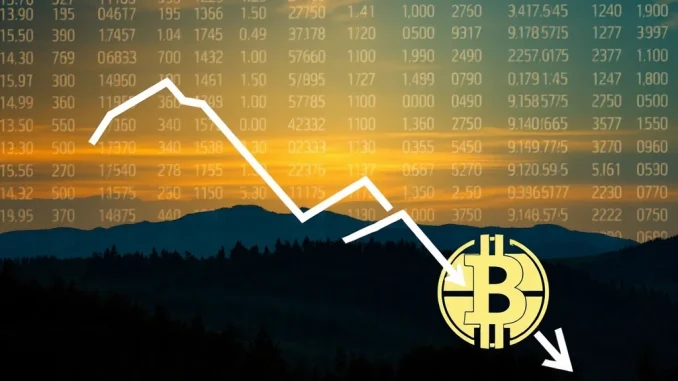
The financial world is keeping a close eye on Wall Street today as the US stock market opened with significant losses across major indices. For those navigating the dynamic world of cryptocurrencies, understanding these movements in traditional finance is key. Why? Because increasingly, the performance of stocks, particularly tech-heavy indices like the NASDAQ, can have ripple effects on the volatile crypto market.
Examining the Stock Market Drop Today
Here’s a quick look at how the major US indices started the trading day:
- S&P 500: Down 0.97%
- NASDAQ Composite: Down 1.19%
- Dow Jones Industrial Average: Down 0.73%
This broad-based decline indicates a risk-off sentiment prevailing in the market. Investors appear to be moving away from assets perceived as riskier, which often includes both growth stocks and, at times, cryptocurrencies.
What Does the Stock Market Drop Mean for Crypto?
The relationship between traditional stock markets and the crypto space has become more intertwined over time. While cryptocurrencies like Bitcoin were once seen as completely uncorrelated or even an inverse hedge against traditional finance, that narrative has shifted. Here’s how a stock market drop can potentially influence crypto:
Increased Correlation: As institutional money has entered the crypto market, especially into assets like Bitcoin and Ethereum, the correlation with traditional risk assets, particularly tech stocks found in the NASDAQ, has grown. When stocks fall due to macroeconomic concerns (like inflation fears, interest rate hikes, or recession worries), investors may reduce exposure across the board, including crypto.
Risk-Off Sentiment: A downturn in stocks signals a ‘risk-off’ environment. In such times, investors tend to sell assets they deem speculative or high-risk and flock to safer havens (like government bonds or cash). Cryptocurrencies, despite growing adoption, are still widely considered high-risk assets by many traditional investors.
Liquidity Crunch: Significant losses in stock portfolios might force some investors or funds to sell profitable assets elsewhere to cover margin calls or rebalance portfolios. Cryptocurrencies, if held, could be part of this sell-off.
Economic Indicators: The factors driving the stock market down (e.g., unexpected inflation data, hawkish central bank comments) are often the same factors that can negatively impact crypto prices. Both markets are sensitive to changes in global economic outlook and monetary policy.
Is There a Crypto Market Correlation to Watch?
Yes, monitoring the crypto market correlation with indices like the S&P 500 is becoming increasingly important. While not a perfect one-to-one relationship, periods of significant volatility or sustained trends in one market are often reflected in the other. This doesn’t mean crypto will always follow stocks exactly, but ignoring the connection would be unwise for any investor.
Historically, during major sell-offs in traditional markets (like early 2020 or parts of 2022), crypto also experienced significant downturns. Conversely, periods of strong stock market performance have sometimes coincided with bullish runs in crypto.
Navigating Market Volatility: Actionable Insights
So, how should a crypto investor react to news of a falling stock market?
- Stay Informed: Understand the macroeconomic factors driving stock movements, as they likely affect crypto too.
- Assess Your Risk Tolerance: Market downturns test your comfort level with volatility. Ensure your portfolio allocation aligns with your risk appetite.
- Long-Term Perspective: Short-term market fluctuations are normal. If you believe in the long-term potential of your crypto investments, daily price swings might be less concerning.
- Look for Opportunities (with caution): Significant dips can present buying opportunities for those with conviction and capital, but timing the market is difficult.
- Diversify (Wisely): While crypto itself offers diversification within its ecosystem (Bitcoin, Ethereum, altcoins), consider your overall investment portfolio across different asset classes.
A falling US stock market is a signal that broader economic or market-specific headwinds are present. While the crypto market operates 24/7 and has its own unique drivers, it is not immune to the forces impacting traditional finance. Today’s lower open on Wall Street serves as a reminder of the interconnected nature of global markets.
Conclusion: Keep an Eye on Both Markets
Today’s stock market drop, impacting indices like the S&P 500 and NASDAQ, highlights the current cautious sentiment among investors. For the crypto community, this isn’t just distant news; it’s a relevant data point. The increasing crypto market correlation with traditional assets means that understanding movements in stocks is crucial for navigating the potential opportunities and risks in digital assets. Staying informed about both worlds provides a more complete picture for making investment decisions in this complex landscape.



